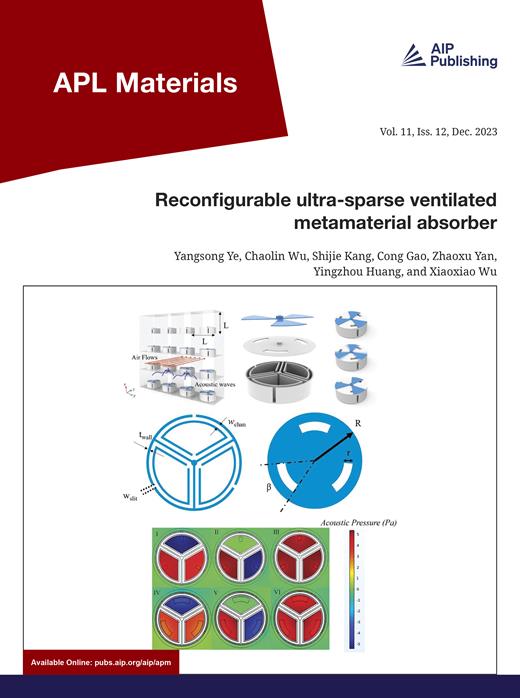Nature-inspired wood-like TPU/CB aerogels for high performance flexible strain sensors
IF 5.3
2区 材料科学
Q2 MATERIALS SCIENCE, MULTIDISCIPLINARY
引用次数: 0
Abstract
Strain sensors based on porous conductive polymers (CPCs) have garnered growing research interest for their potential applications in motion detection, healthcare, human–computer interaction, and artificial intelligence. However, the complexity of CPC processing makes it difficult to achieve the controlled design of microscopic porous structures, leading to simple and random porous structures, thus limiting their further use in the field of pressure sensing. This paper presents a strain sensor with a high-performance, wood-like structure composed of flexible conductive carbon black/plastic polyurethane foam (BWCT) using a bidirectional freeze casting process. The results show that, compared with conventional random freezing and unidirectional freezing, the bidirectional freeze casting process can effectively realize multiscale control of the composite structure, which results in a good laminar porous structure of the prepared BWCT. This parallel laminar structure not only contributes to the layered transfer of stresses but also avoids the local concentration of stresses. At the same time, it significantly increases the directional electrical conduction ability, which results in high sensing stability performance. In particular, the BWCT sensors had a wide detection range (80%), a lower limit of detection (0.2%), rapid response and relaxation times (200 ms), as well as exceptional durability (>2000 cycles). Furthermore, the BWCT was integrated into a wearable sensor to monitor various human motions, including arm bending, squatting, and walking, demonstrating reliable detection performance. Altogether, the BWCT sensors are promising in expanding the application but also offer guidance for designing high-performance wearable strain sensors.灵感源自大自然的仿木热塑性聚氨酯/CB 气凝胶用于高性能柔性应变传感器
基于多孔导电聚合物(CPC)的应变传感器因其在运动检测、医疗保健、人机交互和人工智能领域的潜在应用而引起了越来越多的研究兴趣。然而,由于 CPC 加工的复杂性,很难实现微观多孔结构的可控设计,导致多孔结构简单而随机,从而限制了其在压力传感领域的进一步应用。本文介绍了一种采用双向冷冻铸造工艺,由柔性导电碳黑/塑料聚氨酯泡沫(BWCT)组成的高性能仿木结构应变传感器。结果表明,与传统的随机冷冻和单向冷冻相比,双向冷冻铸造工艺能有效实现复合结构的多尺度控制,从而使制备的 BWCT 具有良好的层状多孔结构。这种平行层状结构不仅有助于应力的分层传递,还能避免应力的局部集中。同时,它还大大提高了定向导电能力,从而实现了较高的传感稳定性能。特别是,BWCT 传感器具有检测范围广(80%)、检测下限低(0.2%)、响应和弛豫时间快(200 毫秒)以及超强的耐用性(>2000 次循环)。此外,BWCT 还被集成到可穿戴传感器中,用于监测各种人体运动,包括手臂弯曲、下蹲和行走,显示出可靠的检测性能。总之,BWCT 传感器有望扩大应用范围,同时也为设计高性能可穿戴应变传感器提供了指导。
本文章由计算机程序翻译,如有差异,请以英文原文为准。
求助全文
约1分钟内获得全文
求助全文
来源期刊

APL Materials
NANOSCIENCE & NANOTECHNOLOGYMATERIALS SCIE-MATERIALS SCIENCE, MULTIDISCIPLINARY
CiteScore
9.60
自引率
3.30%
发文量
199
审稿时长
2 months
期刊介绍:
APL Materials features original, experimental research on significant topical issues within the field of materials science. In order to highlight research at the forefront of materials science, emphasis is given to the quality and timeliness of the work. The journal considers theory or calculation when the work is particularly timely and relevant to applications.
In addition to regular articles, the journal also publishes Special Topics, which report on cutting-edge areas in materials science, such as Perovskite Solar Cells, 2D Materials, and Beyond Lithium Ion Batteries.
文献相关原料
公司名称
产品信息
阿拉丁
Dioxane
 求助内容:
求助内容: 应助结果提醒方式:
应助结果提醒方式:


